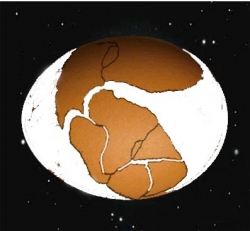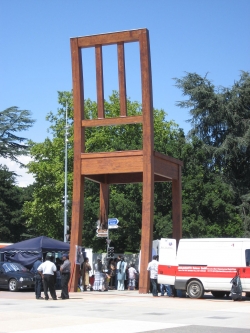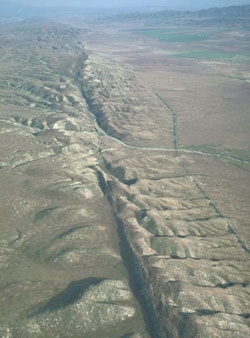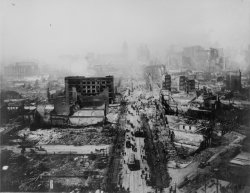Our Earth's crust is broken into twenty pieces. Kind of like the cracked shell of a boiled egg. These pieces slide around the hot middle of our Earth. Sometimes they bump into each other. Sometimes they slide under or over each other. And sometimes they slide right past each other. When they slide past each other, it's kind of like having a room full of BIG pieces of furniture that are all touching but need to be moved around. And you have to do it slowly because there are glasses of water and dollhouses sitting on top of them, just like houses and lakes sit on top of Earth's crust. Sound difficult? Imagine how our Earth feels.

This egg is not all it's cracked up to be.
Furniture sliding past each other is not very dangerous. But what if they took up the whole room? When they slid, they would rub against each other, and they would be hard to move. A
transform boundary is a fault line where two plates of the Earth's crust slide past each other side to side. When you do this with furniture, they might rub each other a little bit. But because the Earth is made of dirt and rocks, the plates crunch into each other. They transform. Please do not push the furniture pieces together so hard they crunch.

Some furniture is just easier to move than others.
Imagine you have a neighbor who lives on the other side of a transform boundary. Wave to them. "Hello, neighbor!" Now, as the crust pushes together, they might build up so much pressure that they all of a sudden slips. It's like if you have been pushing, pushing, pushing into a table and then it gives! A
strike-slip fault is when one part of the Earth slides past another and it doesn't have to be between two plates. "Bye, neighbor!" . . . Not really. They will only jump over a few inches.
Lucky for us, most of these boundaries are at the bottom of the ocean. We try not to build on top of the ones on land. You really only have to worry about losing your neighbor if you are a squirrel or a fish, or if you live somewhere like San Francisco. The most famous transform boundary is a
place called the
San Andreas Fault, which is between
the North American plate and Pacific Plate. The first plate is pushing Southern California toward the north, into the ocean. If you do not like getting shaken up, you might want to live somewhere else. Then again, if you want to see what it's like for land to snap off into an island and float away, this is the best place to try it.

The San Andreas fault looks like someone cracked a giant cookie in half.
Original author: Robert E. Wallace, USGS (federální úřad USA), Public domain, via Wikimedia Commons
Back to you pushing and pushing and pushing into that table. All of that pushing you put into it made it jump forward and all of the things standing on top of it fell over! In 1906 the same thing happened on Earth. All that pushing on the San Andreas Fault gave in, and a piece of the Earth broke like a cracker. The San Francisco Earthquake was a large earthquake in 1906 that damaged most of the city. Pressure has been building again over the last one hundred years, and there could be another one at any time. But when they built their city again, they made so it would stand strong during earthquakes. Kind of like taping things down to the table before you move them.

In San Francisco, the earthquake was really bad but the fire that followed destroyed the city.
See page for author, Public domain, via Wikimedia Commons
Fun Fact! Just as there are earthquakes, there are also
moonquakes! But they're not nearly as strong as ours. Anyone want to
live in a moon house?
So moving Earth plates are a little bit different than moving furniture. Tables do not tend to break and they do not have real people living on them. But if you think about the two pieces of furniture rubbing up against each other, how they stop because there is a lot of friction, and how they will all of a sudden jump forward, you can get a good idea of why all of the little houses and people living on transform boundaries could be in trouble. Now, let's do something we cannot do to the Earth. Take all of the stuff off the tables and flip them on their sides. There. Now, that's better.
References:USGS. "The Science of Earthquakes" USGS, 2010. <
http://earthquake.usgs.gov/learn/kids/eqscience.php>
Weather Wiz Kids. "Earthquakes" Weather Wiz Kids, 2012. <
http://www.weatherwizkids.com/weather-earthquake.htm>
Kids Fun Science. "Transform Boundary" Kids Fun Science, 2011. <
http://www.kids-fun-science.com/transform-boundary.html>
Random History. "60 Fascinating Facts About . . . Earthquakes" Random History, 2010. <
http://facts.randomhistory.com/earthquake-facts.html>
Iris. "What are the 4 basic classes of faults" Iris, 2013. <
http://www.iris.edu/hq/programs/education_and_outreach/animations/2>
Scientific American. "Could We Harness Energy From Earthquakes? Not Likely" Scientific American, 2011. <
http://www.scientificamerican.com/article.cfm?id=could-we-harness-energy-from-earthquakes>